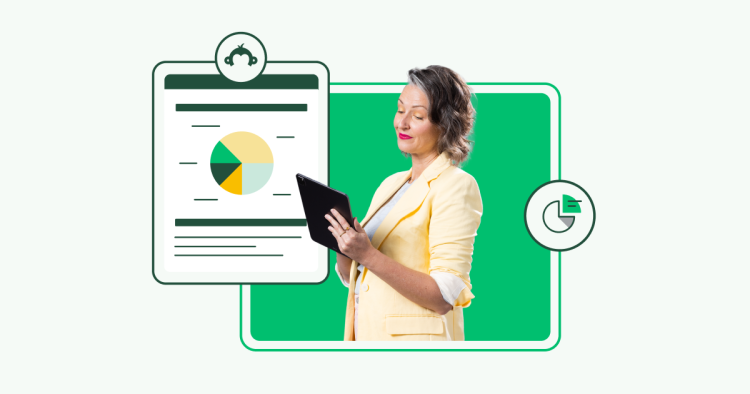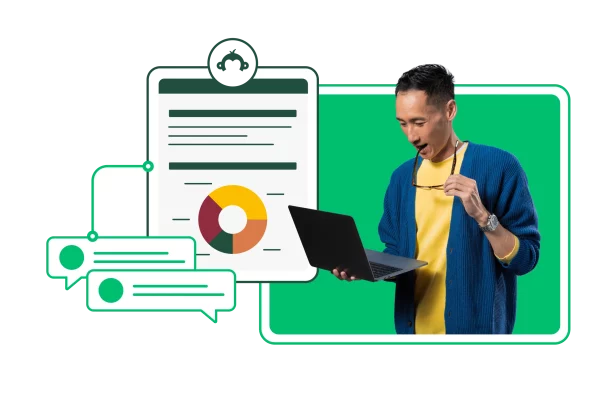경쟁사에 대한 인사이트를 찾고 있든, 고객 충성도를 강화해야 하든, 가장 소중한 도구 중 하나는 고객 피드백입니다.
왜일까요? 고객 피드백은 어떤 부분을 잘하고 있고 어떤 점이 잘못되었는지를 이해하는 데 도움이 되며 개선을 위해 필요한 정보를 제공하기 때문입니다. 하지만, 고객 의견 수집에는 또 다른 방법이 있습니다. 좀 더 구체적으로 말하자면, 포커스 그룹을 운영할 것인지 설문조사를 진행할 것인지 둘 중 하나를 선택해야 합니다.
포커스 그룹 및 설문조사의 장단점과 이 각각을 고객 인사이트를 확보하기 위해 언제 사용해야 하는지에 대한 안내를 제공하여 결정을 내리는 데 도움을 드리고자 합니다.
포커스 그룹에 대한 설명
연구자가 포커스 그룹을 수행할 땐 특정 목표 시장이나 사용자 페르소나를 대표할 수 있는 몇 명의 사람들을 신중하게 선택합니다. 포커스 그룹을 진행하는 동안, 연구자는 그룹 참가자들에게 질문하고 참가자들이 함께 논의할 수 있도록 유도합니다. 일반적으로 포커스 그룹은 상호 교류식으로 진행되며, 사람들이 자신의 의견을 솔직하게 말하기에 편안한, 중립적인 장소에서 진행합니다.
즉, 포커스 그룹에서 얻은 데이터를 통해 고객들이 어떻게 생각하는지, 그리고 왜 그런 생각을 하는지에 대한 소중한 인사이트를 얻을 수 있습니다. 이러한 조사 방법은 시장에 맞는 제품을 개발하거나, 몰입도가 높은 마케팅 캠페인을 만들거나, 시장 변화에 대응하는 데 도움이 됩니다.
설문조사에 대한 설명
설문조사는 특정 사람들을 대상으로 의견을 수집하는 데 사용되는 조사 방법입니다. 설문조사는 정량적 조사로 분류되는 경향이 있으며 포커스 그룹 결과와는 달리 결정을 내릴 수 있는 결과를 제공할 수 있습니다.
설문조사는 예산과 시기 면에서 큰 유연성을 제공합니다. 하지만 일단 실행하기 시작하면 변경 사항이 지나치게 많지 않아야 하므로 유연성이 없는 것으로 볼 수도 있습니다. 또한, 정확한 데이터를 수집하려면 질문에 일관성이 있어야 합니다.

포커스 그룹 또는 설문조사를 사용해야 하는 경우
포커스 그룹 패널이나 설문조사를 선택하기 전에 조사 질문을 적어 두세요. 그런 다음 해당 질문들에 대해 더 많은 질문을 합니다. 즉, 이 조사를 수행하는 데 필요한 정보의 종류를 생각해 보세요.
- 일방적인 질문을 통해 만족스러운 답변을 얻을 수 있을까요, 아니면 대화를 나누는 것이 더 효과적일까요?
- 설명이 더 필요한 개념이나 사용자 경험을 테스트하고 싶은가요?
- 참가자들의 반응을 직접 관찰하고 싶은가요?
- 소수의 의견에 따라 결정을 내리는 것이 괜찮다고 생각되나요?
- 통계적 유의성이 있는 결과를 얻기 위해 더 큰 표본 크기로부터 수집한 의견이 필요한가요?
포커스 그룹을 사용하여 고객이나 목표 시장에 더 가깝게 접근할 수 있습니다. 고객에게 동기를 부여하고, 즐겁게 하는 것이 무엇인지, 또는 어떤 문제나 불편 사항을 가지고 있는지에 대해 귀를 기울일 수 있습니다. 이러한 인사이트를 통해 신제품 또는 새로운 서비스에 대한 정보, 경쟁력 있는 인사이트를 확보하거나 고객의 목소리 프로그램을 더욱 강화할 수 있습니다.
설문조사는 종종 특정한 상황과 연관되므로 데이터를 분석하여 조직에 목표가 분명하며 구체적인 개선 사항을 만들 수 있습니다. 예를 들어, 지원 팀에 연락을 한 모든 고객에게 고객 서비스 피드백 설문조사를 보낼 수 있습니다. 확보한 피드백은 주요 고객 서비스 지표를 추적하고 목표가 정해진 개선을 수행하는 데 도움이 됩니다.

포커스 그룹 및 설문조사의 장단점
아직도 포커스 그룹이나 설문조사 중 어떤 것을 사용해야 할지 잘 모르겠나요? 다음은 고객 또는 시장 조사에 사용할 서비스를 결정하는 데 도움이 되는 유용한 목록입니다.
포커스 그룹
장점
- 고객이 직접 전달하는 고객 피드백을 접할 수 있습니다.
- 내부 팀은 미처 고려하지 못했었지만 고객에게는 중요할 수 있는 아이디어와 문제점을 발견할 수 있습니다.
- 논의하는 동안 문제에 대해 더 심도 있게 살펴볼 수 있는 유연성을 갖습니다.
- 구체적인 후속 질문을 함으로써 고객 피드백을 명확하게 이해할 수 있습니다.
단점
- 경비에는 참가자 모집, 시설 대여, 중재자 및/또는 에이전시 요금, 참여 보상, 그룹을 보기 위해 여러 장소를 여행해야 하는 것이 포함될 수 있습니다.
- 그룹 토론을 지배하는 몇몇 사람들로 인해 참가자들의 의견이 왜곡될 수 있습니다.
- 소요되는 시간으로 인해 자격을 갖춘 참가자를 모집하는 데 어려움이 있습니다.
- 계획, 조직, 모집 및 여행(필요할 수도 있음)을 하는 데 상당한 시간과 노력이 소요됩니다.
설문조사
장점
- 피드백을 신속하게 받을 수 있습니다. 응답자의 수에 따라 24~48시간 이내에 결과를 받아볼 수 있습니다.
- 조사를 한 번 디자인하면 그 후에도 동일한 설문조사를 계속해서 다시 보낼 수 있는 방법을 제공합니다. (더 나아가 이런 방식으로 벤치마크와 결과 추적이 수월해집니다.)
- 설문조사가 익명 응답을 허용하는 경우, 응답자들은 더욱 편안하게 솔직한 의견을 제공할 수 있습니다.
- 두 가지 이상의 고객 유형에게 동시에 접근한 다음 변수를 기준으로 데이터를 여러 측면으로 분석할 수 있습니다.
단점
- 고객 및 시장 조사의 경우, 고객 연락처 정보가 없으면 참가자를 모집하는 데 문제가 있을 수 있습니다.
- 구체적인 후속 질문을 통해 고객 피드백을 명확히 이해할 수 있는 기회가 없습니다.
- 참가자들이 설문조사에 포함되지 않은 사안에 대해 능동적으로 피드백을 제공할 방법이 없습니다.
- 설문조사 길이는 결과에 영향을 미치기 때문에 할 수 있는 질문이 제한되어 있습니다. 길이가 긴 설문조사에는 사려 깊고 완성된 응답을 제공하지 않을 가능성이 높습니다.
두 가지 조사 유형 모두 준비 과정은 비슷합니다.
포커스 그룹이나 설문조사를 성공적으로 진행하는 방법
1. 목표 수립
설문조사를 작성하거나 포커스 그룹 패널을 수행하기 전에, 조사 목표를 수립해야 합니다. 이 목표는 앞으로 진행하거나 결정을 내리는 데 필요한 사항입니다.
목표가 한 개이든 여러 가지이든 (너무 많은 목표는 삼가세요!) 목표를 수립하면 설문조사나 포커스 그룹 질문을 더욱더 다듬을 수 있습니다. 어느 경우이든 설문조사 응답자와 포커스 그룹 참가자들은 질문을 더욱 수월하게 이해할 수 있을 것입니다.
목표를 정의할 땐 회사 목표 또는 관련 KPI에 맞춘 조사를 진행할 수 있습니다. 또한, 주요 내부 이해관계자들과 협력하여 정말 유용한 정보를 제공하는 질문을 하는지 확인하는 것도 좋은 방법입니다.
2. 참가자 모집
설문조사나 포커스 그룹에 어떤 사람들이 참여하길 원하시나요? 이와 마찬가지로 중요한 질문은 어떤 사람을 제외하고 싶은가 입니다.
참가자는 조사의 성공에 있어 매우 중요합니다. 나이, 성별, 가구 소득, 직업, 거주 지역을 포함한 인구 통계 정보를 생각해 보세요.
응답자들의 연락처 정보를 알고 계시나요? 아니면, 목표 시장을 설문조사하는 데 도움을 줄 연구 패널이 필요하신가요? 응답자나 참가자들이 회사의 제품이나 제품 분류에 익숙해 있길 원하시나요?
설문조사를 수행할 적합한 사람들을 찾는 데 도움이 필요하다면 SurveyMonkey Audience가 해당 기준에 따라 원하는 대상이 누구든 접근할 수 있게 해줍니다.
3. 포커스 그룹 논의 가이드 개발
논의 가이드는 포커스 그룹에서 진행자가 사용하는 스크립트라고 할 수 있습니다. 논의 가이드는 대화를 구성하고, 논의 속도를 조절하고, 목표에 대해 다루며, 모든 참가자들의 참여를 유도합니다. 논의 가이드를 만들기 전에 다음을 고려해야 합니다.
- 진행자가 해야 하는 질문
- 질문에 대한 참가자들의 답을 얻기 위해 진행자가 프로젝트에 대해 알아야 할 사항
- 개념이나 시제품을 테스트하는 경우 진행자가 참가자들에게 제공할 수 있는 단서나 팁
- 진행자가 올바른 후속 질문을 하기 위해 연구 목표에 대해 알아야 할 사항
연구자와 함께 작업하는 경우, 조직의 목표와 부합하는 포커스 그룹 목표 및 목적을 주제로 시작해야 합니다. 팀원들과 협업하여 올바른 방식으로 질문하고, 너무 많은 주제나 활동으로 참가자들이 압박감이 들지 않도록 하세요.
4. 효과적인 설문조사 질문 작성
설문조사를 직접 만드는 경우, 효과적인 설문조사 질문을 작성하고 일반적인 설문조사 실수를 피하기 위해 다음과 같은 모범 사례를 따르도록 합니다.
- 유도적이거나 함축적인 질문은 삼갑니다
- 이중적 질문은 사용하지 않도록 합니다
- 민감한 설문조사 질문을 할 땐 주의를 기울입니다
- 명확하고 직관적인 언어를 사용합니다
- 올바른 질문 유형을 사용합니다
항상 초점을 잃지 않도록 해야 합니다. 목표는 어떤 질문을 하는가에 대한 방향을 제시해 줍니다. 거래형 설문조사 또는 관계형 설문조사를 만들거나, 폐쇄형 질문이나 개방형 질문 수 사이에 균형을 맞출 땐, 목표를 항상 염두에 두어야 합니다.
5. 포커스 그룹 참가자 준비에 대한 고려
효과적인 포커스 그룹 대화를 위해서는 참가자들의 준비가 필요합니다. 참가자들이 그룹 대화에서 편안하고 자신감을 가질 수 있도록 준비를 통해 기대치를 설정할 수 있습니다.
참가자 준비는 다음과 같은 것들을 포함합니다.
- 포커스 그룹 장소, 시간 및 기간 공유
- 참가자들에게 논의 주제에 대한 정보 제공
- 기밀 유지 계약을 포함하여 규칙이나 정책 설명
연구를 시작하기 전에 참가자들이 해야 할 활동이나 과제가 있나요? 전화나 이메일 연락을 통해 포커스 그룹에 앞서 이를 위한 일정을 참가자들에게 알리는 것도 좋습니다.
6. 보상을 위한 예산 확보
고객 참여에 대한 인센티브 제공의 장단점을 비교해 보세요. 보상해 줄 수 있다면 참가자들에게 소요한 시간에 대한 보상을 얼마나 해줄 수 있나요? 1시간 이상 소요되는 길이가 긴 설문조사나 포커스 그룹의 경우 기프트 카드 제공을 고려해 보세요.
금액에 대해 신중을 기해야 한다는 것을 염두에 두어야 합니다. 금액이 너무 크면 자격이 안 되는 사람도 설문조사에 응답하거나 포커스 그룹에 참여할 수 있습니다. 금액이 너무 적으면 사람들이 사려 깊은 응답을 제공할 의욕이 없을 수도 있습니다.
포커스 그룹과 설문조사에 대한 최종 의견
일반적으로, 고객들과 방향을 잡아주는 대화를 가지길 원한다면 포커스 그룹을 이용하는 것이 좋습니다. 잘 정의된 질문이 있고 대규모 또는 복수의 고객 그룹에게 접근해야 한다면 설문조사가 더 적합합니다.
다행히도 각 프로젝트에 대해 한 가지 방법만 선택하지 않아도 됩니다. 설문조사와 포커스 그룹으로부터 확보하는 인사이트는 서로를 보완합니다. 설문조사는 결론을 도출하는 데 필요한 정량적 데이터와 통계적으로 유의성 있는 결과를 제공할 수 있습니다. 하지만 포커스 그룹은 목표 시장이나 고객들의 의견을 반영하여 데이터 뒤에 숨은 ‘이유’를 제공할 수 있습니다.
자신 있게 목표 시장 조사
포커스 그룹이나 설문조사를 진행할 준비가 되셨나요? SurveyMonkey가 시장 조사에 강력한 도움을 드릴 수 있습니다. 광고와 새로운 개념을 테스트하고, 브랜드 상태를 모니터링하며, 경쟁사에 대한 인사이트 등을 확보하세요. 목표 시장에 접근하는 것에 대해 더 자세히 알아보세요.
리소스 더 살펴보기

브랜드 마케팅 관리자
브랜드 마케팅 관리자들은 이 도구 키트를 사용하여 타겟팅하는 대상 그룹을 이해하고, 브랜드를 키워나가며, ROI를 증명할 수 있습니다.

2025년에 알아야 AI 마케팅 통계
마케터의 88%가 일상 업무에 AI를 사용합니다. 2025년에는 마케팅 전문가들이 AI를 어떻게 사용할지, 또 회사가 AI 트렌드에서 어떻게 앞서 나갈 수 있는지 알아보세요.

소비자 제품 및 서비스를 위한 SurveyMonkey 솔루션 보기
생활소비재, 여행 및 접객을 포함한 소비자 제품 및 서비스 산업에서 SurveyMonkey 인사이트로 다음 단계를 설계합니다.

소매업계용 SurveyMonkey 솔루션 알아보기
소매업계가 진화하는 시장 동향을 파악하고, 고객에게 만족스러운 제품을 개발하며, 사랑받는 브랜드를 구축하는 데 SurveyMonkey가 어떻게 도움이 되는지 알아보세요.
